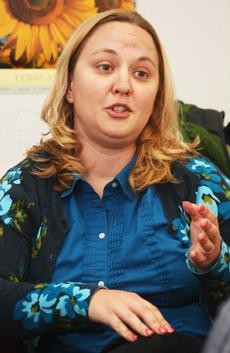The relationship between an undergraduate and their graduate teaching assistant can often make or break a student’s experience in a class where access to a professor is limited or non-existent. But recent budget cuts have prompted concern about the future of that relationship.
“”The number of students per TA is expected to go up,”” said Stephen Bieda, atmospheric sciences doctoral student and president of the Graduate Professional Student Council.
“”This year, the number we had is 50-70 students per TA. We’re expecting it to be even higher next semester, probably 150 students per TA,”” Bieda said.
Numbers for next year may be uncertain, but what is certain is that the number of available TA positions has been cut by almost 40 since 2006. However, concerns about the number of TA positions for next semester were alleviated last night at the GPSC meeting with President Robert Shelton.
Bieda said that at the meeting it was agreed that if Arizona receives the share of federal stimulus money it is currently vying for, some of that would be used as a stop-gap measure to ensure that the number of TA positions is not decreased next semester.
Nevertheless, Bieda said, while the number of TA’s may remain unchanged, class sizes are sure to increase.
“”There’s no doubt about that, and there’s no doubt that (increased class size) is a major concern for undergrads,”” Bieda said.
“”(Having a higher-student-TA ratio) doesn’t serve student interests on both sides because (graduate students) end up having to teach more students, which means we have less personal free time to do our own class work as well as our own research,”” Bieda said. “”It doesn’t serve the undergraduate population because you get less personal time with an instructor that actually cares.””
Jennifer Martin, French masters student and TA for French 101, agreed.
“”It’s very hard for the graduate students to be put into classes with like 300 or 500 students, and there aren’t enough graduate students to handle that many. Everyone suffers,”” Martin said.
An increased student-TA ratio not only decreases the quality of education for undergraduates, but also puts significantly more stress on already overworked TA’s, said Lucy Blaney, Spanish doctoral student and College of Humanities representative for GPSC.
“”You are being asked to pay more for less,”” Blaney said. “”I estimate that for each new student I get, I have to spend another 20-30 minutes a week grading, and meeting for office hours, phone calls, emails, all that kind of stuff. The less time I have overall, the worse it gets for the students because I can only stretch myself so thin before things get out of hand. The number one complaint of students about their classroom experience is not getting enough feedback.””
Blaney added that offering bigger classes would “”absolutely”” result in fewer applications to graduate programs at the UA.
“”If you get crummy offers, and some (other school) is offering you a lighter teaching load for similar pay, that’s a pretty sweet deal. It’s making us uncompetitive,”” she said.
The number of graduate students entering the UA each year has dropped sharply in recent years, from 2,614 in 2003 to 1,878 in 2008, according to the UA Fact Book.
Ultimately, Blaney said, having the right student-TA ratio is an indispensible part of the education process.
“”If you get rid of people it doesn’t matter how good the book is, or how good the technology is,”” Blaney said. “”You cannot replace really good material and really good teachers with technology or new paint or a nice pretty building. It won’t work. It might look good, but it won’t work.””









